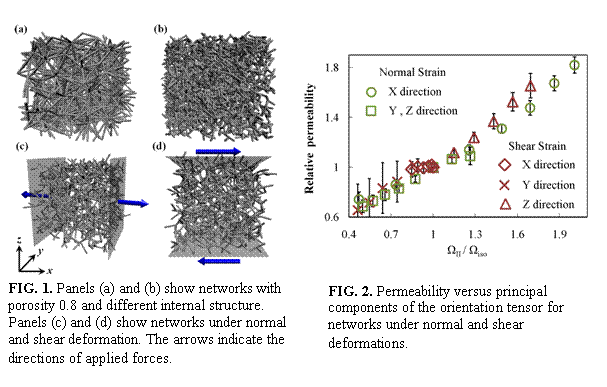AmericanChemicalSociety.com
Reports: DNI6 48911-DNI6: Using Soft Polymers to Regulate Friction Between Sliding Surfaces
Alexander Alexeev, PhD, Georgia Institute of Technology
The main goal of this project is to examine the effect of surface compliance and nanoscale structure on the friction forces between rubbing surfaces. In order to reach our goals, we have developed a mesoscale computational mode of elastic gel in viscous fluid. Specifically, we use bond-bending lattice spring model to capture the micromechanics of random networks of interconnected filaments that represent elastic gels. This lattice of elastic filaments captures the mechanical properties of the disordered polymer networks.1
We have coupled the lattice spring model with the dissipative particle dynamics that is used to explicitly model the flow of viscous fluids. Figure 1 shows internal structures of polymer gels created using our modeling approach.
To validate our model, we have examined transport properties of gels. To this end, we constructed polymer networks with different porosity and internal structures and studied the network permeability and diffusivity. In our permeability studies, we found good agreement between our permeability-porosity results and the experimental data from the literature for isotropic porous media.2 We have demonstrated that the permeability of random filament networks depends solely on the network volume fraction and does not depend on the network internal structure, which is in agreement with previously reported results. 3
To probe the diffusivity, we introduced different nanoparticles and polymer chains and followed their diffusion through the polymer network. Our simulations revealed that the diffusion coefficient of solid particles is smaller than that of flexible polymers with a similar coil size. That is due to the ability of polymeric chains to change and deform when a chain diffuses through a network.
Polymer gels covering rubbing surfaces experience elastic deformations. This mechanical deformation gives rise to changes in the network internal orientation and, thereby, alters the network transport properties. We have, therefore, studies the effect of network inhomogeneity due to mechanical stretching and shearing on the transport properties of polymer gels.
We have found that the transport properties of mechanically deformed networks are defined by the porosity and filament orientation within the network. We have characterized the network alignment using a second order orientation tensor and demonstrated that network permeability is directly related to the magnitudes of principal tensor components. Figure 2 presents the results for network permeability under mechanical load obtained from multiple simulations of networks with different internal structure and porosity. We have found that all data collapses into a single master curve and depends nearly linearly on the magnitude of the orientation tensor eigenvalues. Since the orientation tensor can be measured experimentally, this approach opens a new way for assessing the permeability of deformable random networks under mechanical load.
We have also studied how to design surface nanoscale topography in order to regulate the flow and spatial distribution of nanoparticles and polymer chains. We have showed that surfaces lined with nanoscopic posts can selectively attract or repel suspended nanoparticles and polymeric chains via hydrodynamic interactions. The hydrodynamic forces can be tailored through specific surface topography, thereby allowing to engineer smart materials with responsive surface properties that can be harnessed to regulate interactions within system, e.g. friction.
Figure 3 shows snapshots from our simulations illustrating distribution of particles and chains near surfaces decorated with tilted nanoscopic posts. When the posts are tilted along the flow, they create near-wall fluid currents that direct particles and polymers towards the wall, thereby making the chemically non-adhesive surface hydrodynamically attractive to the suspended species. When we changed the post orientation such that they are directed against the flow, we found that post and particles are repelled from the surfaces to the bulk fluid. We also found that the effect of the posts is different for nanoparticles and chains. Thus, these structured surfaces not only can be harnessed to regulate the distribution in lubricating fluids, but also to trap and filter out specific entities and separate different particles and chains.
We currently employ the developed gel model to probe the friction forces between two rubbing surfaces coated with polymer gels (Fig. 4). In these studies, we examine the effect of gel mechanical properties and internal structure on the lubrication of sliding surfaces and probe how these properties can be tailored to regulate the specific friction behavior of the system.
References:
1. G. A. Buxton and N. Clarke, Phys Rev Lett 98 (23), 238103 (2007).
2. L. Spielman and S. L. Goren, Envr Sci & Tech 2 (4), 279-287 (1968).
3. P. L. Chandran, T. Stylianopoulos and V. H. Barocas, Multiscale Model Sim 7 (1), 22-43 (2008).
Copyright © American Chemical Society



